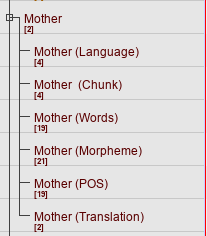2. Dependent Tiers
Contents
2.1 Background
For a video version of this section, see the “Intro to ELAN dependent tiers” video from our playlist.
Tiers in ELAN can be independent or be dependent on/refer to other tiers. Independent tiers consist of annotations linked to the time axis. Dependent tiers contain annotations linked to annotations on a primary/parent tier, and can optionally be linked to the time axis. These dependent tiers are in hierarchical primary-secondary (parent-child) relationships.
The image below is an example of a tier hierarchy. “Mother” is the primary tier with six secondary tiers (Language, Chunk, Words, Morpheme, POS, and Translation)
Note: ELAN formally refers to the dependent tiers as “parent” and “child” tiers. This may be a bit confusing in our context as we transcribe recorded discourse from actual families. As such, the parent tier will henceforth be referred to as “primary”, and the child tier will be “secondary”
Changes made to the primary tier, such as deleting the tier or adjusting the time interval, will affect the secondary tier. The primary tier’s time interval cannot be adjusted independently. Moreover, deleting the secondary tier will not affect the primary tier.
Back to table of contents
2.2 Tier type stereotypes
Each tier is assigned a type stereotype (constraints enforced on the tier). For example, whether or not the annotations in a primary tier will be subdivided in the secondary tier and time-aligned. The choice of which stereotype is used depends on the objectives and purpose of a transcription task. The table below is a summary of ELAN tier type stereotypes.
| Stereotype Name | Dependent (i.e., must have primary tier) | Time-aligned | Sub-divided annotations | Description | Example |
|---|---|---|---|---|---|
| None | No | Yes | No | Cannot have a primary tier. Non-overlapping annotations on an independent tier linked to the time axis |  |
| Time Subdivision | Yes | Yes, with no time gaps | Yes | Sub-divided annotations from the primary tier that are linked to the primary’s time interval. No time gaps between sub-divided annotation units. |  |
| Included in | Yes | Yes, with time gaps | Yes | Similar to Time Subdivision, but time gaps are allowed (e.g., if there is silence in a sentence). |  |
| Symbolic Subdivision | Yes | No | Yes | Sub-divided annotations that cannot be linked to time intervals. No time gaps allowed. |  |
| Symbolic Association | Yes | No | No | One-to-one correspondence between annotation on primary tier and secondary tier. (e.g., a translated version of the primary tier) |  |
Back to table of contents
